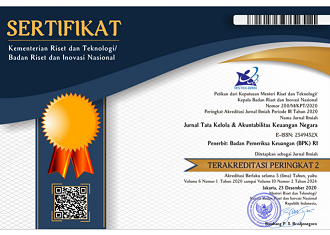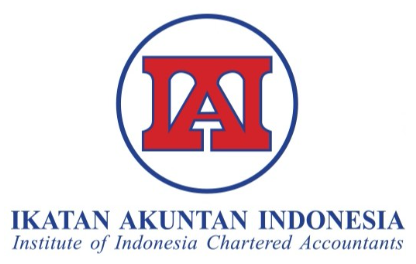An experiment on bribery, tenure duration, and punishment severity in the Indonesian public finance context
DOI:
https://doi.org/10.28986/jtaken.v9i2.1508Keywords:
Corruption, Public Officials Long-Tenure, Bribery, Lab experiment, Sequential game, IndonesiaAbstract
Against the backdrop of increasing concern over corruption, this study delves into a laboratory experiment investigating the intricate dynamics of bribery concerning the duration of official tenures and the efficacy of punitive measures. Experimental methods prove pivotal in unraveling the complexities inherent in corrupt behaviors. The study unfolds a compelling pattern, shedding light on the interplay between public officials and civilians, particularly emphasizing the impact of officials' tenure duration on bribery. It brings forth a crucial correlation between familiarity with officials and a heightened likelihood of bribery, with extended tenures amplifying this susceptibility. The concept of "fixed pairing" accentuates the role of prolonged official incumbency in influencing bribery tendencies. Additionally, introducing punitive measures with financial repercussions proves effective in curbing bribery incidents and associated givebacks, particularly when applied to bribe recipients, suggesting heightened stakes public officials face. The study demonstrates the potential of dual treatments involving random pairings and punitive approaches to reduce the magnitude of bribes and givebacks. This study underscores the necessity of curtailing prolonged official tenures to mitigate bribery tendencies, offering insights into enhanced governance and ethical conduct through strategic rotational shifts and robust penalties. These comprehensive findings contribute valuable perspectives to addressing corruption and enhancing ethical standards within public institutions.
References
Abbink, K., Irlenbusch, B., & Renner, E. (2002). An experimental bribery game. Journal of Law, Economics, and Organization, 18(2), https://www.jstor.org/stable/3555050
Abbink, K. (2006). Laboratory experiments on corruption. In S. Rose-Ackerman (Ed.), International Handbook on the Economics of Corruption (pp. 418-437). Edward Elgar Publishing.
Adam, I., & Fazekas, M. (2021). Are emerging technologies helping win the fight against corruption? A review of the state of the evidence. Information Economics and Policy, 57, 100950. https://doi.org/10.1016/j.infoecopol.2021.100950
Ajzen, I. (1985). From intentions to actions: A theory of planned behavior. In J. Kuhl & J. Beckman (Eds.), Action-control: From Cognitions to Behavior (pp. 11–39). Springer, Heidelberg.
Anti Corruption Clearing House (ACCH). (2015). Penanganan TPK berdasarkan jenis perkara. http://acch.kpk.go.id/en/statistik-penanganan-tindak-pidana-korupsi-berdasarkan-jenis-perkara.
Association of Certified Fraud Examiners (ACFE). (2014). Report to the nation on occupational fraud and abuse. https://www.acfe.com/-/media/files/acfe/pdfs/2014-report-to-nations.pdf
Banerjee, R. (2016). On the interpretation of bribery in a laboratory corruption game: Moral frames and social norms. Experimental Economics, 19(1), 240–267. https://doi.org/10.1007/s10683-015-9436-1
Banerjee, R., Dasgupta, U., & Mitra, S. (2023). Stopping the Rot I: A review of models and experimental methods of corruption experiments. In C. K. Jha, A. Mishra, & S. Sarangi (Eds.), The Political Economy of Corruption. Routledge. https://doi.org/10.4324/9781003142300
Banuri, S., & Eckel, C. (2015) Cracking down on bribery. Social Choice Welfare, 45, 579–600. https://doi.org/10.1007/s00355-015-0883-6.
Barr, A., Lindelow, M., & Serneels, P. (2009). Corruption in public service delivery: An experimental analysis. Journal of Economic Behavior & Organization, 72(1), pp. 225–239. https://doi.org/10.1016/j.jebo.2009.07.006.
Basu, K. (2011). Why, for a class of bribes, the act of giving a bribe should be treated as legal. (MPRA Paper No.50335). https://ideas.repec.org/p/pra/mprapa/50335.html
Basu, K., Basu, K., & Cordella, T. (2016). Asymmetric punishment as an instrument of corruption control. Journal of Public Economic Theory, 18(6), 831–856. https://doi.org/10.1111/jpet.12212
BBC News Indonesia. (2023, April 21). Disorot harta kekayaannya yang “tidak sesuai profil”, KPK meminta klarifikasi Kadinkes Lampung. BBC News Indonesia. https://www.bbc.com/indonesia/articles/c2elp5rl11zo
Campos-Vazquez, R. M., & Mejia, L. A. (2016). Does corruption affect cooperation? A laboratory experiment. Latin American Economic Review, 25(1), 1–19. https://doi.org/10.1007/S40503-016-0035-0/FIGURES/4
CNBC Indonesia. (2023, July 5). Jabatan kepala desa ditambah jadi 9 tahun, segini gajinya! CNBC Indonesia. https://www.cnbcindonesia.com/news/20230705080006-4-451399/jabatan-kepala-desa-ditambah-jadi-9-tahun-segini-gajinya
Cohen, J. R., Holder-Webb, L., Sharp, D. J., & Pant, L. W. (2007). The effects of perceived fairness on opportunistic behavior. Contemporary Accounting Research, 24(4), 1119–1138. https://doi.org/10.1506/car.24.4.3
Coviello, D., & Gagliarducci, S. (2017). Tenure in office and public procurement. American Economic Journal: Economic Policy, 9(3), 59-105. https://doi.org/10.1257/pol.20150426.
Deci, E. L., Koestner, R., & Ryan, R. M. (1999). A meta-analytic review of experiments examining the effects of extrinsic rewards on intrinsic motivation. Psychological Bulletin, 125(6), 627–668. https://doi.org/10.1037/0033-2909.125.6.627
Delios, A., Malesky, E. J., Yu, S., & Riddler, G. (2023). Methodological errors in corruption research: Recommendations for future research. Journal of International Business Studies, 1–17. https://doi.org/10.1057/S41267-023-00637-8/TABLES/5
Engel, C., Goerg, S. J., & Yu, G. (2016). Symmetric vs. asymmetric punishment regimes for collusive bribery. American Law and Economics Review, 18(2), 506–556. https://doi.org/10.1093/aler/ahw005
Castro, F. M. (2021). To bribe or not to bribe? An experimental analysis of corruption. Italian Economic Journal. 7, 487–508. https://doi.org/10.1007/s40797-020-00129-w
Garcia-Vega, M., Herce, J. A. (2011). Does tenure in office affect regional growth? The role of public capital productivity. Public Choice, 146, 75–92. https://doi.org/10.1007/s11127-009-9584-y
Georgesen, J. C. & Harris, M. J. (1998). Why's my boss always holding me down? a meta-analysis of power effects on performing evaluation. Personality and Social Psychological Review, 2(3), 184-195. https://doi.org/10.1207/s15327957pspr0203_3
Gneezy, U., Saccardo, S., & van Veldhuizen, R. (2019). Bribery: Behavioral drivers of distorted decisions. Journal of the European Economic Association, 17(3), 917–946. https://doi.org/10.1093/jeea/jvy043
Guerra, A., & Zhuravleva, T. (2021). Do bystanders react to bribery? Journal of Economic Behavior & Organization, 185, 442–462. https://doi.org/10.1016/J.JEBO.2021.03.008
Hegarty, W. H., & Sims, H. P. (1978). Some determinants of unethical decision behavior: An experiment. Journal of Applied Psychology, 63(4), 451-457. http://dx.doi.org/10.1037/0021-9010.63.4.451
Jancsics, D. (2014). Interdisciplinary perspectives on corruption. Sociology Compass, 8(4), 358–372. https://doi.org/10.1111/soc4.12146
Keltner, D., Gruenfeld, D., & Anderson, C. (2003). Power, approach, and inhibition. Psychological Review, 110, pp. 265–284. https://doi.org/10.1037/0033-295X.110.2.265
Kusumasari, D. (2011, Desember 23). Perbedaan antara suap dengan gratifikasi. Hukumonline. http://www.hukumonline.com/klinik/detail/cl3369/perbedaan-antara-suap-dengan-gratifikasi
Lagunes, P. (2021). The eye and the whip: Corruption control in the Americas. Oxford University Press. https://doi.org/10.1093/oso/9780197577622.001.0001
Law of The Republic of Indonesia Number 20 of 2001 concerning Eradication of Corruption (Undang-Undang Nomor 20 Tahun 2001 tentang Perubahan atas Undang-Undang Nomor 31 Tahun 1999 tentang Pemberantasan Tindak Pidana Korupsi). https://peraturan.bpk.go.id/Details/44900/uu-no-20-tahun-2001
Mahmud, A. A., & Rezvi, M. R. (2022). A strategy for asymmetrical measures to reduce bribery in Bangladesh. Politicon: Jurnal Ilmu Politik, 4(2), 183-204. https://doi.org/10.15575/politicon.v4i2.17593
Mazar, N., & Aggarwal, P. (2011). Greasing the palm: Can collectivism promote bribery? Psychological Science, 22(7), 843–848. https://doi.org/10.1177/0956797611412389
Mietzner, M. (2015). Indonesia’s direct elections: Empowering the electorate or entrenching the New Order oligarchy. In E. Aspinall & G. Fealy (Eds.), Soeharto's New Order and its Legacy: Essays in Honour of Harold Crouch. ANU ePress. https://library.oapen.org/bitstream/handle/20.500.12657/33621/459541.pdf?sequence=1
Moskowitz, D. (1994). Cross-situational Generality and the Interpersonal Circumplex. Journal of Personality and Social Psychology, 66(5), 921-933. https://doi.org/10.1037/0022-3514.66.5.921
Moskowitz, D. S. (2004). Does elevated power lead to approach and reduced power to inhibition? Comment on Keltner, Gruenfeld, and Anderson (2003). Psychological Review, 111(3), 808-811. https://doi.org/10.1037/0033-295X.111.3.808
Murphy, J., & Albu, O. B. (2018). The politics of transnational accountability policies and the (re)construction of corruption: The case of Tunisia, Transparency International and the World Bank. Accounting Forum, 42(1), 32–46. https://doi.org/10.1016/J.ACCFOR.2017.10.005
Nekovee, M., & Pinto, J. (2019). Modeling the impact of organization structure and whistle-blowers on intra-organizational corruption contagion. Physica A: Statistical Mechanics and its Applications, 522, 339-349. https://doi.org/10.1016/j.physa.2019.01.140
Peisakhin, L. (2012). Transparency and corruption: Evidence from India. The Journal of Law and Economics, 55(1), 129–149. https://doi.org/10.1086/663727
Persson, A., Rothstein, B., & Teorell, J. (2013). Why anticorruption reforms fail-systemic corruption as a collective action problem. Governance, 26(3), 449–471. https://doi.org/10.1111/j.1468-0491.2012.01604.x
Roberts, J. (2009). No one is perfect: The limits of transparency and an ethic for ‘intelligent’ accountability. Accounting, Organizations and Society, 34(8), 957–970. https://doi.org/10.1016/J.AOS.2009.04.005
Robinson, A. L., & Seim, B. (2018). Who is targeted in corruption? disentangling the effects of wealth and power on exposure to bribery. Quarterly Journal of Political Science, 13(3). https://doi.org/10.1561/100.00017067
Rose-Ackerman, S. (1986). Reforming public bureaucracy through economic incentives? Journal of Law, Economics, and Organization, 2(1), 131–161. https://doi.org/10.1093/oxfordjournals.jleo.a036903
Rothstein, B., & Varraich, A. (2017). Making sense of corruption. Cambridge University Press. https://doi.org/10.1017/9781316681596
Schram, A., Zheng, J. D., & Zhuravleva, T. (2022). Corruption: A cross-country comparison of contagion and conformism. Journal of Economic Behavior & Organization, 193, 497–518. https://doi.org/10.1016/j.jebo.2021.11.017.
Sekretariat Jenderal MPR RI. (2023, January 30). Sjarifuddin Hasan: Kekuasaan yang terlalu lama menyebabkan otoritarian. https://www.mpr.go.id/berita/Sjarifuddin-Hasan-:- Kekuasaan-Yang--Terlalu-Lama-Menyebabkan--Otoritarian
Senjaya, I. C. (2023, January 26). Pakar: Masa jabatan terlalu panjang cenderung picu korupsi. ANTARA News Makassar. https://makassar.antaranews.com/berita/458046/pakar-masa- jabatan-terlalu-panjang-cenderung-picu-korupsi
Suhardiman, D., & Mollinga, P. P. (2017). Institutionalized corruption in Indonesian irrigation: An analysis of the upeti system. Development Policy Review, 35(S2), 0140–0159. https://doi.org/10.1111/dpr.12276
Sutherland, E. H., Cressey. D. R., & Luckenbill, D. F. (1992). Principles of criminology (11th Edition). General Hall Inc
The Economist Intelligence Unit. (2021). Democracy index 2021. Economist Intelligence. https://www.eiu.com/n/campaigns/democracy-index-2021/
The Economist Intelligence Unit. (2022). Democracy index 2022. Economist Intelligence. https://www.eiu.com/n/campaigns/democracy-index-2022/
Transparency International (2022). Indonesia corruption perceptions index. https://www.transparency.org/en/cpi/2022/index/idn
van Veldhuizen, R. (2013). The influence of wages on public officials’ corruptibility: A laboratory investigation. Journal of Economic Psychology, 39, 341–356. https://doi.org/10.1016/j.joep.2013.09.009
Wihantoro, Y., Lowe, A., Cooper, S., & Manochin, M. (2015). Bureaucratic reform in post-Asian Crisis Indonesia: The Directorate General of Tax. Critical Perspectives on Accounting, 31, 44–63. https://doi.org/10.1016/j.cpa.2015.04.002
Downloads
Submitted
Accepted
Published
How to Cite
Issue
Section
License
Copyright (c) 2023 Jurnal Tata Kelola dan Akuntabilitas Keuangan Negara

This work is licensed under a Creative Commons Attribution-ShareAlike 4.0 International License.

Jurnal Tata Kelola dan Akuntabilitas Keuangan Negara is licensed under
a Creative Commons Attribution-ShareAlike 4.0 International License




















